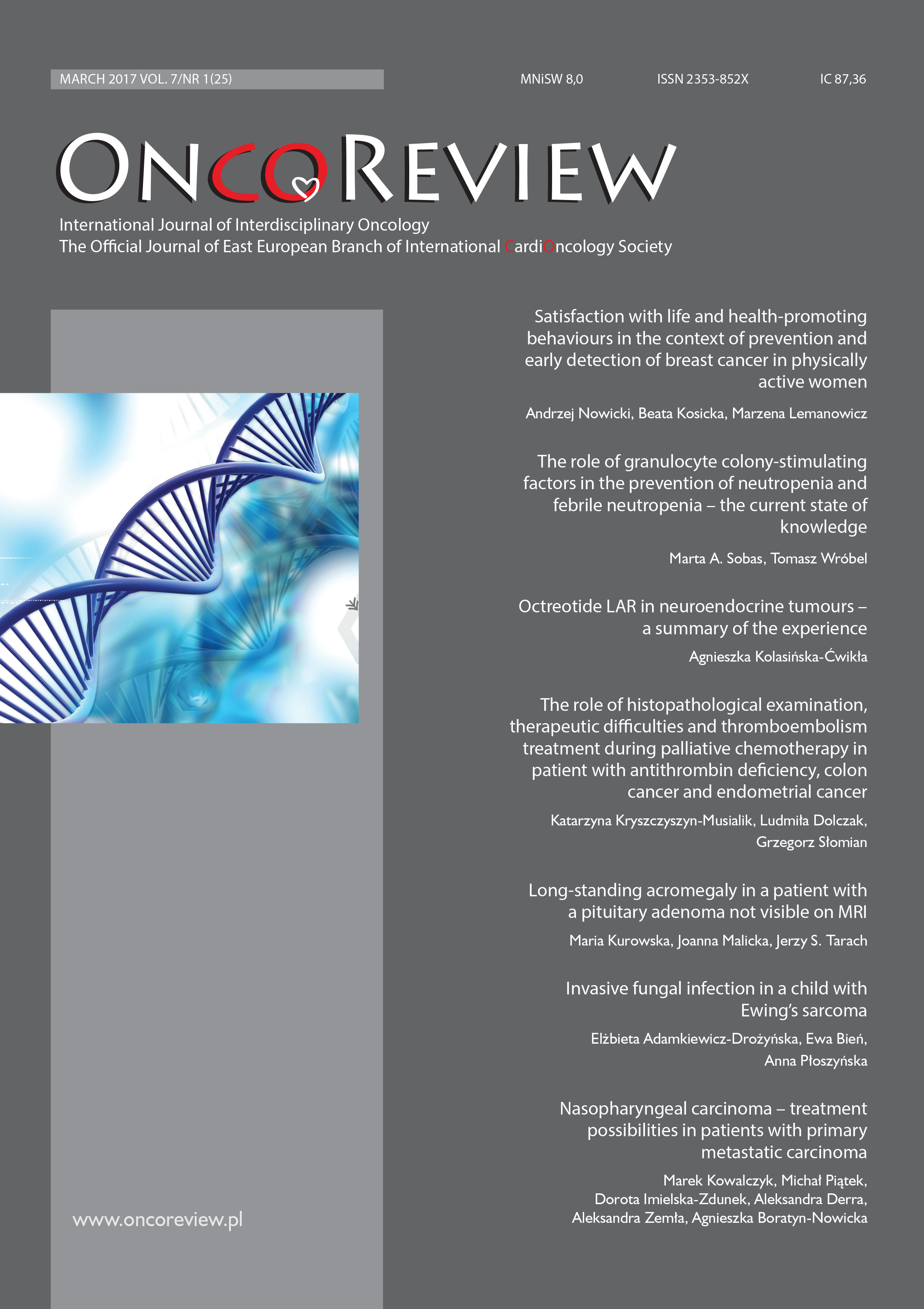Satisfaction with life and health-promoting behaviours in the context of prevention and early detection of breast cancer in physically active women Original article
Main Article Content
Abstract
Objective: Assessment of the impact of life satisfaction in physically active women on their health-promoting behaviours in terms of prevention and early detection of breast cancer.
Materials and methods: The study, involving 100 women, was carried out in a fitness centre in Bydgoszcz in 2015. The research instruments used included the authors’ self-designed questionnaire and the SWLS life satisfaction score.
Results: Women aged 25–34 constituted 57% of the study participants, with 82% of them domiciled in the city, and 74% of them holding secondary or higher education qualifications. 67% of them assessed their knowledge about breast cancer and breast cancer prevention programme as good, 65% of them believed it was impossible to protect oneself from cancer, 68% of them occasionally consumed alcohol. 89% of the respondents engaged in breast self-examination, and 68.4% of the subjects aged 25–34 considered excessive weight/obesity as a risk factor. 61.5% of women aged 45–60 were smokers. Respondents living in the city would dedicate one hour more for physical activity than those from the countryside. 93.2% of women with secondary/tertiary education carried out breast self-examination. Surveyed women received high scores on the scale of life satisfaction, averaging 25.69 points, they were less likely to smoke cigarettes, and more likely to engage in breast self-examination (95.5%).
Conclusions: Physically active women assess their knowledge on health-promoting behaviours well, lead a healthy lifestyle, and avoid breast cancer risk factors. Physically active women accomplish a high level of life satisfaction, which is especially true for married women with a higher education degree. On the other hand, life satisfaction does not correlate with age, place of residence or marital status. Women presenting a high level of life satisfaction are more involved in health-promoting behaviours, carry out regular breast self-examination, and undergo preventative medical check-ups.
Downloads
Metrics
Article Details

This work is licensed under a Creative Commons Attribution-NonCommercial 4.0 International License.
Copyright: © Medical Education sp. z o.o. This is an Open Access article distributed under the terms of the Attribution-NonCommercial 4.0 International (CC BY-NC 4.0). License (https://creativecommons.org/licenses/by-nc/4.0/), allowing third parties to copy and redistribute the material in any medium or format and to remix, transform, and build upon the material, provided the original work is properly cited and states its license.
Address reprint requests to: Medical Education, Marcin Kuźma (marcin.kuzma@mededu.pl)
References
2. Tkaczuk-Włach J, Sobstyl M, Jakiel G. Rak piersi – znaczenie profilaktyki pierwotnej i wtórnej. Przeg Menopauz 2012; 4: 343-347.
3. Pedišć Ž, Greblo Z, Phongsavan P et al. Are total, intensity and domain- specific physical activity levels associated with life satisfaction among University Students. PLoS One 2015; 10(2): e0118137. http://doi.org/10.1371/journal.pone.0118137.
4. Malicka I, Szczepańska-Gieracha J, Jankowska E et al. Physical activity, life satisfaction and adjustment to illness in women after treatment of breast cancer. Współcz Onkol 2015; 15: 180-185.
5. Hornowska E. Testy psychologiczne: teoria i praktyka. Scholar, Warszawa 2007: 136.
6. Pacian A, Ferenc W, Jędrasik M. Wiedza młodych kobiet na temat profilaktyki raka piersi. Med Paliatywna 2014; 6: 151-157.
7. Przysada G, Bojczuk T, Kuźniar A et al. Poziom wiedzy kobiet na temat profilaktyki i wczesnego rozpoznawania raka piersi. USMYJ 2009; 3: 129-136.
8. Leźnicka M, Mierzwa T, Jachimowicz-Wołoszynek D, Żyrkowski J. System indywidualnych zaproszeń a zgłaszalność kobiet na badania profilaktyczne wykonywane w ramach programów z zakresu profilaktyki onkologicznej. Probl Hig Epidemol 2009; 90: 627-630.
9. Nowicki A, Miłecka A. Wyniki badań profilaktycznych w kierunku raka piersi realizowanych w latach 2004-2005 w powiecie sierpeckim. Współcz Onkol 2007; 11: 437-443.
10. Charzyńska-Gula M, Bartosiewicz AM, Bogusz R. Opinia społeczna na temat chorób nowotworowych-badanie retrospektywne. Medycyna Ogólna i Nauki Zdrowiu 2014; 20: 223-228.
11. Mazur-Roszak M, Litwiniuk M, Grodecka-Gazdecka S. Otyłość a rak piersi. Współcz Onkol 2010; 14: 270-275.
12. Karczmarek-Borowska B, Stryjkowska A, Grądalska-Lampart M, Grybel M. Poziom wiedzy kobiet z terenów wiejskich na temat raka piersi. Medical Review 2013; 3: 298-310.
13. Zych B, Marc M, Binkowska-Bury M. Stan wiedzy kobiet po 35. roku życia w zakresie profilaktyki raka piersi. Przegląd Medyczny Uniwersytetu Rzeszowskiego 2006; 1: 27-33.
14. Paździor A, Stachowska M, Zielińska A. Wiedza kobiet na temat profilaktyki raka piersi. Nowiny Lekarskie 2011; 80: 419-422.
15. Gacek M. Wybrane zachowania zdrowotne grupy kobiet w środowisku wiejskim i miejskim w świetle statusu socjoekonomicznego i stanu odżywienia. Probl Hig Epidemiol 2011; 92: 260-266.
16. Topolska M, Sapuła R, Topolski A et al. Aktywność fizyczna a zdrowie kobiet w wieku od 19 do 65 lat wśród różnych dziedzin życia. Zamojskie Studia i Materiały 2011; 1: 27-36.
17. Nowicki A, Olszewska A, Humańska M. Wykrywanie raka piersi poprzez samobadanie. Badanie retrospektywne u kobiet po operacji. Ginekol Pol 2007; 78: 293-298.
18. Suszyńska K, Kulik B, Pacian A. Ocena zachowań prozdrowotnych dotyczących profilaktyki raka piersi u kobiet w makroregionie lubelskim. Medycyna Ogólna i Nauk o Zdrowiu 2013; 19: 370-374.
19. Piróg M, Podgórniak M, Putowski M et al. Opieka ginekologiczna wśród młodych kobiet w Polsce z zastosowaniem technologii medycznych. EJMT 2014; 3: 17-23.
20. Grant N, Wardle J, Steptoe A. The relationship between life satisfaction and health behavior: a cross-cultural analysis of young adults. Int J Behav Med 2009; 16: 259-268.
21. Inal S, Subasi F, Ay SM, Hayran O. The links between health-related behaviors and life satisfaction in elderly individuals who prefer institutional living. BMC Health Serv Res 2007; 7: 1-7.

